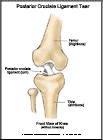
Posterior Cruciate Ligament Injury
What is a posterior cruciate ligament sprain?
A sprain is a joint injury that causes a stretch or tear in a ligament. A ligament is a strong band of tissue that connects one bone to another. The posterior cruciate ligament is one of the major ligaments in the knee. It connects the thigh bone (femur) to the shin bone (tibia). This ligament, along with the anterior cruciate ligament, helps keep the knee stable and protects the femur from sliding or turning on the tibia.
Sprains are graded I, II, or III, depending upon their severity:
- grade I sprain: pain with minimal damage to the ligament
- grade II sprain: more ligament damage and mild looseness of the joint
- grade III sprain: complete tearing of the ligament and the joint is very loose or unstable.
How does it occur?
The posterior cruciate ligament can be injured by a direct blow to the front of the knee while the knee is bent and the foot is planted. Posterior cruciate ligament tears are not common.
What are the symptoms?
You may recall a direct blow and possibly a painful pop. You may have swelling with fluid (called an effusion) in the knee joint. Your knee may feel loose.
If you have torn your posterior cruciate ligament in an injury that occurred months or years ago and you haven't had reconstructive surgery, you may have the feeling that the knee is giving way during sporting activities.
How is it diagnosed?
Your health care provider will examine your knee and may find that it is too loose. An x-ray may be taken to see if there are any injuries to the femur or tibia. An MRI (magnetic resonance imaging) scan may help diagnose posterior cruciate ligament tears.
How is it treated?
Treatment may include:
- applying ice packs to your knee for 20 to 30 minutes every 3 to 4 hours for 2 or 3 days or until the pain goes away
- elevating your knee by placing a pillow underneath it
- wrapping an elastic bandage around your leg to keep the swelling from getting worse
- using crutches
- doing knee rehabilitation exercises.
You and your health care provider will decide if you need to have surgery. The torn posterior cruciate ligament cannot be sewn back together. The ligament must be reconstructed by taking ligaments or tendons from other parts of your leg and connecting them to the tibia and femur.
When can I return to my sport or activity?
The goal of rehabilitation is to return you to your sport or activity as soon as is safely possible. If you return too soon you may worsen your injury, which could lead to permanent damage. Everyone recovers from injury at a different rate. Return to your sport or activity will be determined by how soon your knee recovers, not by how many days or weeks it has been since your injury occurred. In general, the longer you have symptoms before you start treatment, the longer it will take to get better.
You may safely return to your sport or activity when, starting from the top of the list and progressing to the end, each of the following is true:
- Your injured knee can be fully straightened and bent without pain.
- Your knee and leg have regained normal strength compared to the uninjured knee and leg.
- Your knee is not swollen.
- You are able to jog straight ahead without limping.
- You are able to sprint straight ahead without limping.
- You are able to do 45-degree cuts.
- You are able to do 90-degree cuts.
- You are able to do 20-yard figure-of-eight runs.
- You are able to do 10-yard figure-of-eight runs.
- You are able to jump on both legs without pain and jump on the injured leg without pain.
If you feel that your knee is giving way or if you develop pain or have swelling in your knee, you should see your health care provider.
How can I prevent a posterior cruciate ligament sprain?
Unfortunately, most injuries to the posterior cruciate ligament occur during accidents that are not preventable. However, you may be able to avoid these injuries by having strong thigh and hamstring muscles and maintaining a good leg-stretching routine. When you are skiing, be sure your ski bindings are set correctly by a trained professional so that your skis will release when you fall.

